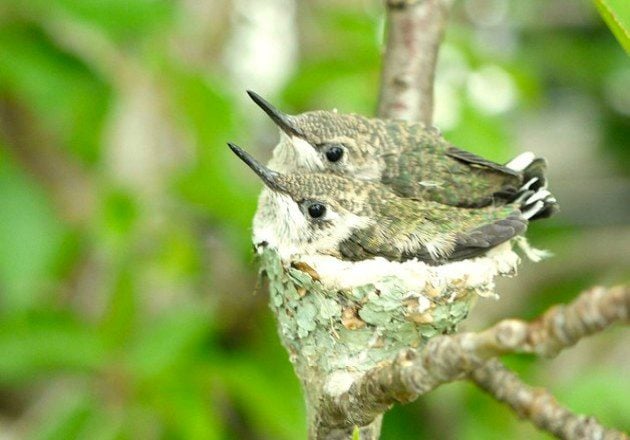Bird Nesting Marvels
Updated: Dec. 05, 2022

Discover some of the most amazing bird nesting marvels in North America.
When most people think of a bird’s nest, they probably imagine a grassy little bowl, held together with weed stalks and mud, in the crook of a tree. While this does describe the typical nest of an American robin, it doesn’t even come close for many other backyard birds.
Though nests all serve the same purpose-—to secure the eggs and young—the shape, depth, material and location vary greatly. Sizes range anywhere from a hummingbird’s golf-ball-size nest covered in lichens (pictured here) to a bald eagle’s giant platform of sticks, high in a treetop and sometimes weighing more than a ton.
Nearly every species has its own unique nesting habits. Take a look at some of the most fascinating nesters in the birding world.
Burrowing owl. Like foxes and woodchucks, some birds nest underground. But the burrowing owl just might be the most unusual. Most other owls nest in cavities, shelters or on the ground, but this flier actually digs its own 4- to 8-foot tunnel. It lays its eggs on the far end of the chamber. When the owlets are old enough to be curious, you can see their heads poking up at the entrance of a nesting burrow, looking around like kit foxes.
Belted kingfisher. Also an underground nester, the belted kingfisher digs its own burrow in the bare earth near the top of an exposed bank along a lake or river.
Chimney swift. Many birds make their own glue to hold their nests together. In China, a swift makes its entire nest from a gluelike substance it excretes from its bill. Here in North America, the chimney swift uses its gluey saliva to stick its nest to the inside of chimneys. Another common bird that glues its nest with mud is the barn swallow.
Common murre. Among the seabirds, the common murre will lay its eggs on the bare ledge of a sea cliff. The shape of the eggs offers natural protection: They’re long ovals with pointed ends, which makes them roll in a circle and not over the cliff.
American coot. A handful of waterbirds will build floating nests, creating small islands. The American coot typically constructs a cupped platform of cattails, rotted bulrushes or reeds, floating on 1 to 4 feet of water and attached to nearby aquatic plants.
Great horned owl. Like the peregrine falcon, the California condor and other raptors, this owl may construct a nest in a rock cavity or cave entrance on the face of a cliff.
Killdeer. Many birds build no nests at all. One of the best known of these is the killdeer, which lays four speckled eggs on gravel driveways, stony fields or walkways. When flushed off their eggs, the birds will feign a broken wing to distract the intruder from the eggs. Shortly after the eggs hatch, the chicks follow their parents away from the “nest.”
Baltimore oriole. Perhaps the most creative of all nest builders is the female Baltimore oriole. She weaves an intricate 8-inch pouch, attached to twigs high in an elm, maple or willow tree. With the entrance at the top, both parents feed the young by stretching downward into the pouch to reach the open mouths.
Atlantic puffin. This clown-faced shorebird prefers to nest under rocks along the coast of Maine and eastern Canada. (The black guillemot also nests like this.)
Cliff swallow. Though many birds use mud in their nests, only cliff swallows use tiny mud balls to construct globes, resembling adobe houses, attached to cliffs or the sides of buildings. You can find entire colonies nesting side by side in these mud condos.
Brown-headed cowbird. Often dubbed a “lazy bird,” this flier lays its eggs in another bird’s nest. Here’s the history behind the habit: When the bison roamed the great prairies, cowbirds followed the herd to eat the insects the animals attracted or disturbed. To keep up with the moving herd, they laid their eggs in the nests of birds that stayed in one place. As a result of this survival strategy, cowbirds never build their own nests nor raise their own young.
Whip-poor-will. Like its relatives, the whip-poor-will lays its two light-brown eggs on the dead leaves of a forest floor. It’s almost impossible to spot these eggs with the naked eye unless you flush the parent from the nest.
Marsh wren. This bird is also a weaver. Marsh wrens weave a sort of glove lashed to standing cattails, reeds or small bushes about 1 to 3 feet above the water. The entrance is on the side, and the inside is tiny compared to the outside dimensions.
Plover. Like terns, plovers lay their eggs on bare, sandy beaches, among seashells that look like the eggs. This helps protect them from the eyes of predators.
Bird Nesting Notes
Longest incubation period: Varies, though there’s a record of an albatross incubating its egg for 68 days.
Shortest incubation period: Though 12 to 14 days is normal for an American robin, one record shows only seven days before hatching. Hummingbirds require up to 16 days.
Most eggs: If an egg is removed from the nest of a domestic hen every day, she will lay another to replace it, up to 300 eggs a year. Northern flickers will do the same. One flicker laid 71 eggs in 73 days to replace the one egg removed each day.
Most eggs in a single season: Though northern bobwhites normally lay around 20 eggs in a single nest, as many as 40 have been found in one nest, probably laid by two or three hens. Bobwhites and wood ducks are among the few species that will “dump” their eggs in the nests of other hens of the same species.
